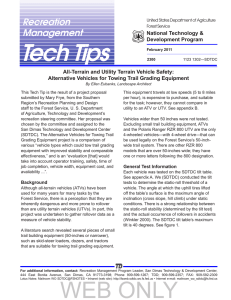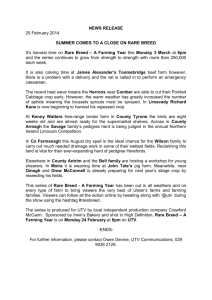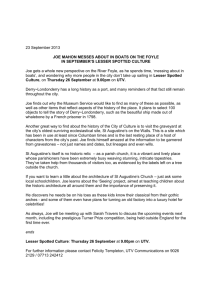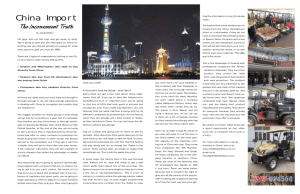Tech Tips Recreation Management
advertisement
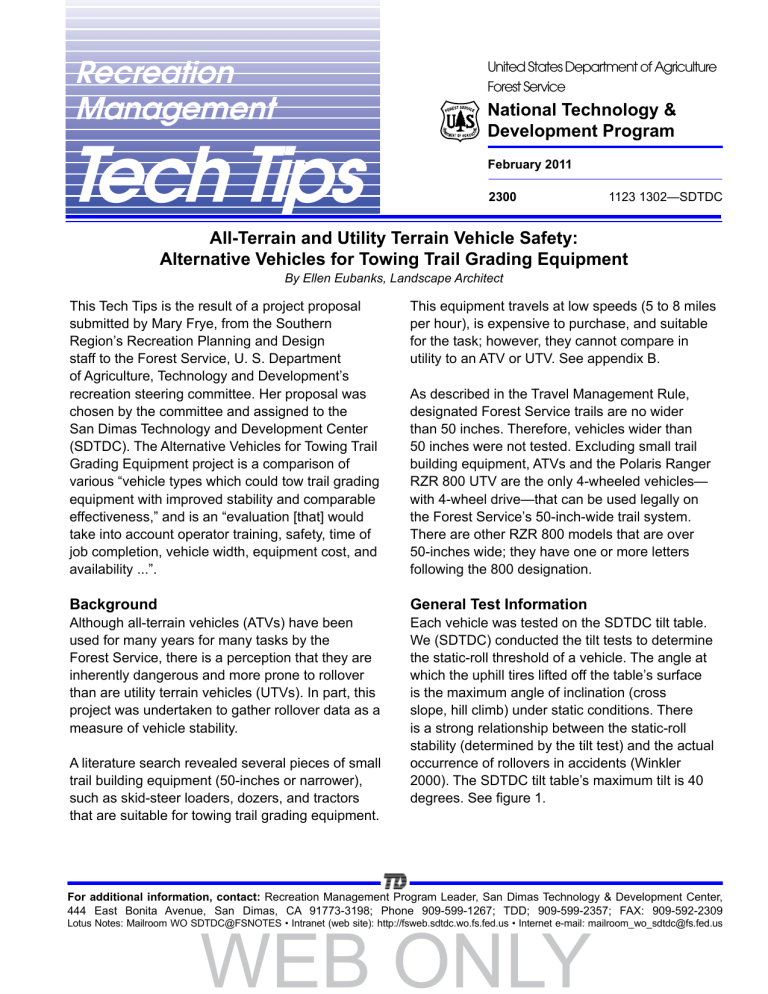
Recreation Management United States Department of Agriculture Forest Service Tech Tips National Technology & Development Program February 2011 2300 1123 1302—SDTDC All-Terrain and Utility Terrain Vehicle Safety: Alternative Vehicles for Towing Trail Grading Equipment By Ellen Eubanks, Landscape Architect This Tech Tips is the result of a project proposal submitted by Mary Frye, from the Southern Region’s Recreation Planning and Design staff to the Forest Service, U. S. Department of Agriculture, Technology and Development’s recreation steering committee. Her proposal was chosen by the committee and assigned to the San Dimas Technology and Development Center (SDTDC). The Alternative Vehicles for Towing Trail Grading Equipment project is a comparison of various “vehicle types which could tow trail grading equipment with improved stability and comparable effectiveness,” and is an “evaluation [that] would take into account operator training, safety, time of job completion, vehicle width, equipment cost, and availability ...”. This equipment travels at low speeds (5 to 8 miles per hour), is expensive to purchase, and suitable for the task; however, they cannot compare in utility to an ATV or UTV. See appendix B. Background General Test Information Although all-terrain vehicles (ATVs) have been used for many years for many tasks by the Forest Service, there is a perception that they are inherently dangerous and more prone to rollover than are utility terrain vehicles (UTVs). In part, this project was undertaken to gather rollover data as a measure of vehicle stability. A literature search revealed several pieces of small trail building equipment (50-inches or narrower), such as skid-steer loaders, dozers, and tractors that are suitable for towing trail grading equipment. As described in the Travel Management Rule, designated Forest Service trails are no wider than 50 inches. Therefore, vehicles wider than 50 inches were not tested. Excluding small trail building equipment, ATVs and the Polaris Ranger RZR 800 UTV are the only 4-wheeled vehicles— with 4-wheel drive—that can be used legally on the Forest Service’s 50-inch-wide trail system. There are other RZR 800 models that are over 50-inches wide; they have one or more letters following the 800 designation. Each vehicle was tested on the SDTDC tilt table. We (SDTDC) conducted the tilt tests to determine the static-roll threshold of a vehicle. The angle at which the uphill tires lifted off the table’s surface is the maximum angle of inclination (cross slope, hill climb) under static conditions. There is a strong relationship between the static-roll stability (determined by the tilt test) and the actual occurrence of rollovers in accidents (Winkler 2000). The SDTDC tilt table’s maximum tilt is 40 degrees. See figure 1. For additional information, contact: Recreation Management Program Leader, San Dimas Technology & Development Center, 444 East Bonita Avenue, San Dimas, CA 91773-3198; Phone 909-599-1267; TDD; 909-599-2357; FAX: 909-592-2309 WEB ONLY Lotus Notes: Mailroom WO SDTDC@FSNOTES • Intranet (web site): http://fsweb.sdtdc.wo.fs.fed.us • Internet e-mail: mailroom_wo_sdtdc@fs.fed.us Among the vehicles, there was only a 3.4 degree difference in angle between the lowest tilt angle and the highest tilt angle at which one tire lifted off the table’s surface. The Foreman and Rubicon’s rear tires lifted first with only 0.10 degree of separation. The Rincon and RZR’s front tires lifted first with only 0.80 degree of separation in degree of tilt. See table 1. Statistics for the second tires are more interesting. The Rubicon rolled at the highest angle. The second tire lifted at 6.5 degrees higher than the first tire. The Foreman’s second tire lifted at 3.5 degrees higher than the first tire, and the 2006/7 Rincon and RZR lifted at 2.2 and 2.1 degrees, respectively. Figure 1—Tilt table shown at 40 degrees. Test results We also tested the ATVs and the UTV for stopping distances on sand, gravel, sandy loam, and packed snow surfaces at the Keweennaw Research Center in Michigan. Results show no significant differences in stopping distances between the ATVs and the UTV. These vehicles were tested on the tilt table: q 2000 Honda Foreman ES 450cc (ATV) (Foreman). q 2005 Honda FourTrax Foreman Rubicon GPScape (ATV) (Rubicon). q 2006/7 Honda FourTrax Rincon 680cc (ATV) (Rincon). q 2008 Polaris Ranger RZR 800 (UTV) (RZR). 2 3 Front 30.8° (58.0%) 32.9° (62.8%) sliding at 26.6° ** Right front wheel up at 39.5° (81.2%) **** Tire pressures for the ATVs were set at approximately 4 pounds, +/- 1 pound of manufacturer’s suggested inflation. The UTV tire pressure was set at 8 pounds. Vehicles’ wheelbase: Rubicon 50.6 inches, Foreman 50.0 inches, Rincon 50.8 inches, RZR 77 inches. *** In increments, brakes let go and grabbed. ** Tires slid very slowly across surface. RZR tires are new and coated with an ArmorAll-type product. 25 x 10 - 12, ~4lb. 600 (4.4 +/- 0.6psi front, pounds 3.6 +/- 0.4psi rear) Tires slide, rear tires on block at 13.8° 25 x 10 - 12, 8lb. 945 (23.4%), 40° (83.9) no tip pounds Brakes slip at 34.5° (67.6%); no change at 40° (83.9%) * Tilt table surface is expanded metal. Maximum tilt is 40 degrees. All test were done with a 175 pound, water-filled dummy strapped to the seat. Polaris Ranger RZR 800 EFI 2008 model year Front 30.0° (57.7%) 32.2° (62.5%) barely perceptible sliding at 21° 586.0 pounds 25 x 8 - 12, 600 ~4lb.**** pounds (3.6 +/- 0.4psi) Brake slipping begins at 13.1° (23.1%). 25 x 10 - 12, ~4lb. At 15.5° (26.9%) front and rear tires (3.6 +/- 0.4psi) on block; 40° (83.9%) no tip Honda Rincon 680cc 2006 model year Vehicle Weight Notes Tire Size and Pressure Honda Foreman ES Rear 27.4° (51.0%) 30.9° (58.0%) 450cc 2000 model year Second wheel up Longitudinal Tilt with 175 Pound Dummy Hill Climb Brake slipping begins at 14.9° (25.2%). At 19.0° (35.0%) rear tire on block; 40° (83.9%) no tip *** First wheel up Lateral Tilt with 175 Pound Dummy Cross-slope 2005 Honda TRX500 Rear 27.5° (51.1%) 34.0° (67.4%) FourTrax Foreman Rubicon GPScape Machine Table 1—US Forest Service SDTDC Tilt Table* Test Results for 3 ATVs and a Polaris Ranger RZR UTV —August 14 & 15, 2008 Conclusions equipped with seatbelts and a rollover protection system (ROP) that protects a driver should he/she lose control. In 2008, personnel at SDTDC tilt-tested three ATVs and the UTV. No significant differences in the vehicles’ rollover points were found. In 2009, ATVs and the UTV were tested during an ATV and snowmobile stop-distance study. The stopping distances were tested using riders of differing skill levels on slopes up to 10.7 percent (approximately 6 degrees) and on several different riding surfaces, including packed snow. No significant differences in stopping distances were found. Workers on the National Forests of Florida—who use the RZR to groom their sandy trails—had this to say, “…the weight distribution is more of a concern. Pulling the sand rake (900 lbs) put a lot of weight on the rear, which makes the front of the RZR light. This lead to handling issues; saying that, I can say that it handles harrow discs and tire-drags well. I think that pulling heavy loads can put more stress on the motor, which can lead to higher maintenance costs. It is a very effective piece of equipment for trails under 50” because of the ROPS, 3-point safety belt, and nets, and the ability to carry a larger variety of tools versus an ATV.” (Ritter 2008) “ … Didn’t work for raking, but they [the crew] like to carry chain saws or signs when they work on 50” trails. They had a couple of warranty issues. Main thing is it runs hot. Air intake is underneath near rear tire. Needs a snorkel to make it higher.” (Schmid 2008) (Note: The 2011 RZR 800 has a larger front grill designed to increase cooling airflow significantly.) The Forest Service Handbook, section 2309.18, Trails Management Handbook, Chapter 22 – trail development, ATV design parameters mandates a design cross slope maximum of 15 percent, or approximately 8.5 degrees. The “Trail Construction and Maintenance Notebook” says, “Keep the grade of each uphill and downhill section less than 10 percent.” (Hesselbarth et al. 2007) Help prevent accidents by restricting cross-country travel to 15 percent slopes, maximum. Overall, the driver determines how “safe” a vehicle is. Driver education, practice, and experience are the most important factors in safe handling of each vehicle type. One report found that, “66% [of accidents] involved riders making poor choices and attempting to cross over terrain that exceeded the limits of the loaded ATV and/or the skill of the rider.” (Lenkeit et al. 2006) See appendix C. Training is required before operating an ATV. The All-terrain Vehicle Safety Institute (ASI), a not-forprofit division of the Specialty Vehicle Institute of America (SVIA), offers low-cost training across the country. An experienced and certified rider also can offer training. Training for UTV certification is under development and will be offered through the ASI. In lieu of official training, some districts require the ATV certification for drivers and then a driving review with someone who has been operating a UTV (Schmid 2010). Compared to the UTV, an ATV is more agile, is significantly shorter, and has a much smaller turning radius. The UTV outweighed the heaviest ATV tested by 300 pounds. A positive feature of the UTV is that it carries two persons. The UTV is 4 References Hesselbarth, Woody; Vachowski, Brian; Davies, Mary Ann. 2007. Trail construction and maintenance notebook. 0723-2806-MTDC. Missoula, MT: U. S. Department of Agriculture, Forest Service, Technology and Development Program, Missoula Technology and Development Center. Document located at: <http://www.fhwa.dot.gov/environment/fspubs/07232806/index.htm>. Lenkeit, J. F.; Kelly, J.; Broen, P. C. 2006. Operational considerations related to the use of ATVs by the Bureau of Land Management. DRI-TR-05-20-3. Dynamic Research, Inc. News & Views. News Releases. 2011 Honda FourTrax Foreman Rubicon/FourTrax Foreman Rubicon with Electric Power Steering and GPScape. August 26 2010. Document located at: <http://www.honda. com/newsandviews/article.aspx?id=5596>. News & Views. News Releases. 2011 FourTrax® Rincon® features & benefits. August 26 2010. Document located at: <http://www.honda.com/newsandviews/article.aspx?id=5594>. Ritter, Daniel. 2008. [Personal communication] August 22. Silver Springs, FL: U. S. Department of Agriculture, Forest Service, Ocala National Forest. SAE International. 1998. A tilt table procedure for measuring the static rollover threshold for heavy trucks. Document Number: J2180. Washington, DC. Schmid, Jim. 2008. [Personal communication] August 20. Tallahassee, FL: U. S. Department of Agriculture, Forest Service, National Forests of Florida. Schmid, Jim. 2010. [Personal communication] September 29. Tallahassee, FL: U. S. Department of Agriculture, Forest Service, National Forests of Florida. Winkler, Chris. 2000. Rollover of heavy commercial vehicles. Ann Arbor, MI: University of Michigan Transportation Research Institute: (31) 4. 5 Appendix A Vehicles Tested The following vehicles were tested on the San Dimas Technology and Development Center (SDTDC) tilt table and in the Michigan stop distance study: q 2000 Honda Foreman ES 450cc. q 2005 Honda FourTrax Foreman Rubicon GPScape 450cc. q 2006/7 Honda FourTrax Rincon 680cc. q 2008 Polaris Ranger RZR 800 760cc. The RZR is in a class of utility terrain vehicles commonly referred to as a UTV cross over. Figure A2—The Rubicon shown strapped during the lateral test. There is a winch on the front and a trailer hitch on the back that add weight. Vehicles were secured to the tilt table by attaching chains loosely to the axles or, in the case of the RZR, to the front axle and to the trailer hitch. On the longitudinal test, the RZR was secured by a half-inch nylon rope. A 175 pound, water-filled dummy was used to represent an average driver. It was strapped to the ATV seat. In the RZR, the dummy was secured by the seat belt. See figures A1 through A5. Figure A3—Rincon chained to the table for the lateral test. Figure A1—Foreman ES strapped and ready for the lateral test. There is a winch and a fire extinguisher on the front and a trailer hitch on the back that add weight. Figure A4—RZR with the dummy strapped in with a seat belt. 6 Figure A5—Dummy strapped for longitudinal test. Note Figure A8—Foreman ES at rolling point, 30.9 degrees. the strap around the “neck” to keep the dummy from tilting backwards. Longitudinal test See figures A9 and A10. 2000 Honda Foreman ES 450cc. Lateral Test See figures A6 through A8. Figure A9—The Foreman ES beginning the longitudinal test. Figure A6—Some distortion in downhill tires on the Foreman Notice that the rear tires are several inches from the blocks. ES. Figure A10—Because of the brakes releasing and catching, the Foreman ES’s rear tires at the end of the test are on the blocks at 40 degrees. Figure A7—Foreman ES rear wheel lifted at 27.4 degrees. 7 Longitudinal test 2005 Honda FourTrax Foreman Rubicon GPScape 450cc. Lateral test See figure A13. See figures A11 through A12. Figure A13—The Rubicon’s rear tires on blocks at 19 degrees. Figure A11—The Rubicon’s rear wheel lifted at 27.5 degrees. 2006/7 Honda FourTrax Rincon 680cc. Lateral test See figures A14 through A16. Figure A12—Rubicon ATV rolls at 34 degrees. Figure A14—The Rincon front tire, in right portion of photograph, is barely off the table at 30.0 degrees. 8 Figure A15—Notice tire distortion. Figure A18—The Rincon tilted at 40 degrees. 2008 Polaris Ranger RZR 800 760cc. Lateral test See figures A19 and A20. Figure A16—The Rincon rolls at 32.2 degrees. Longitudinal test See figures A17 and A18. Figure A19—Front tire of the RZR is off the table at 30.8 degrees. Figure A17—The right front tire lifted off at 39.5 degrees. Figure A20—The RZR rolls at 32.9 degrees. 9 Lateral test Longitudinal test See figure A21. See figures A22-A23 Figure A21—The right front tire lifted off at 30.8 degrees. Figure A22—The RZR ready to begin the longitudinal test. Figure A23—RZR at 40 degrees. Security ropes are still slack and RZR is on blocks. In part, SDTDC tested older models of the ATVs because a forest typically would have older model ATVs, and because that was what was available. Table 2 is included to provide costs for new models and a model year comparison. Except for the 2000 Honda Foreman 4 by 4 ES, the vehicles have not changed significantly. 10 11 Current 45.5 45 50 7.7 11.5 Width (inches) Height (inches) Wheel base (inches) Ground clearance (inches) Turning radius 10.8 feet 10.8 7.5 50.7 46.5 46.8 83 X X 10.8 7.5 50.6 46.4 46.8 83 X X 450cc liquid cooled 2005 Honda TRX500 FourTrax Foreman Rubicon GPScape Tested Tested Current 10.8 7.5 50.6 46.4 46.8 83 X X 499cc liquid cooled 10.8 10 50.8 47.5 46.8 83.2 X X 675cc liquid cooled 10.8 10 50.8 47.5 46.8 83.2 X X 553 3.2 Curb weight (pounds) Fuel capacity (gallons) 4.1 620 X 4 600 X 4 630 X 4.3 600 X 4.3 648 X 7.25 945 1,500 ? 101.5 10 77 69 50 102 X X $6,799.00 $7,699.00 * X means the same as first column Cost - MSRP $8,799.00 $9,999.00 Maximum speed (mph) X* Towing capacity 850 pounds 2008 Polaris Ranger Razor 800 liquid cooled Tested 675cc 760cc liquid cooled 2011 2006 2011 Honda Honda Honda TRX500 FourTrax FourTrax FourTrax Rincon Rincon Foreman 680 680cc Rubicon GPScape Current Payload capacity (pounds) 77 X* Back tire 25 x 10-12 Length (inches) X* Front tire 25 x 8-12 450cc 475cc air cooled air cooled Engine Displacement 2000 2011 Honda Honda Foreman Foreman 4x4 ES 4x4 ES 450cc 475cc Vehicle Features Tested Table 2—Rudimentary Features Comparison Between Tested Vehicles and the Current Model Year $10,999.00 55 7.25 945 1,500 740 101.5 10 77 69 50 103 X X 760cc 2011 Polaris Ranger Razor 800 liquid cooled Current Appendix B Appendix C Small Trail-Building Equipment ATV and UTV Accident Causes Small trail-building equipment can be used to tow trail grading equipment. However, these machines travel at very slow speeds; top speed is 8 mile per hour; bottom speed is 3.4 mile per hour. The loaders don’t pull per se; to drag a tool, the machine is operated in reverse. A hitch can be welded to the front of the machine for attachments not specified for the machine. Tools can be attached to the rear of the Sutter and the Terramite tractor. From: Operational Considerations Related to the Use of ATVs by the Bureau of Land Management (Lenkeit 2006). C. REVIEW OF ATV AND UTV ACCIDENTS DRI was provided with information related to ATV accidents that resulted in vehicle damage, injury or death. This information included a summary table of 36 accidents as well as detailed accident reports for three separate cases. In most cases there was insufficient information to determine whether the involved vehicle was an ATV or UTV. All of these were reviewed in an attempt to identify specific causes or trends that could indicate areas in which safety protocols related to ATV and UTV uses could be improved. All of these accidents involved some form of misuse. This review produced the following observations of the reported accidents: Candidate machines are less than 50 inches wide, are designed to tow, and are available with a hitch. They included: 1. ASV RC 30 (tracked loader), roll-cage, seat belt, $20,000*. 2. Bobcat: Mini Bob S70 (wheeled loader) rollcage, seat belt, $19,000. q 66% involved riders making poor choices and attempting to cross over terrain that exceeded the limits of the loaded ATV and/or the skill of the rider. 4. Cheetah SS16 (wheeled power buggy/ loader), stand mid-machine, $23,000. 5. Sutter 500 (formerly Sweco) (tracked minidozer) with rippers, $ 83,500. q 22% involved ATVs that encountered an obstacle that contributed to the accident. 6. Struck model 4800 (tracked dozer) $14,000. 7. Struck model 7000 (tracked dozer) $16,000. q 19% involved rider control error as a contributing factor. Less than 1 % were [sic] related to high speed. 8. Terramite T5C (wheeled tractor), roll bars $20,000. q 15% involved rider distraction. *retail prices only q 17% involved overturn of ATVs with relatively heavy cargo loads. 50% of these involved a liquid load. For more selections see the Forest Service and Federal Highway Administration mechanized trail building equipment catalog at: <http://www.fhwa. dot.gov/environment/rectrails/equip/equip/index. cfm>. q 28% of the cases involved a rider being able to successfully and voluntarily dismount from the ATV before an upset. These machines are useful for certain types of trail work; they are not useful for everyday maintenance or for getting to a work site. The loaders and dozers are operated using joysticks; the tractor has a steering wheel for the tractor and a joystick for operating an attached tool. A number of businesses offer equipment operation training. Appendix D UTV Safety Letter We include this because it is related to UTV safety. 12 File Code: 6700 Date: September 10, 2010 Route To: Subject: Recent Utility All-Terrain Vehicles Operation Near Misses To: Regional Foresters, Station Directors, Area Director, IITF Director, Deputy Chiefs and WO Directors The Forest Service embraces the Utility All-Terrain Vehicle (UTV) as a useful tool in accomplishing a variety of vital Forest Service missions throughout the country. The UTV, like any piece of specialized equipment, has its intended purposes and inherent limitations. We have experienced a number of recent UTV mishaps that could have resulted in fatalities or serious injuries. Recent incidents include rollovers due to overloading of the UTV cargo bed, altering cargo bed configuration thereby changing the UTV’s center of gravity, mounting non-baffled tanks to the UTV cargo bed, attempting to climb grades exceeding the capability of the loaded UTV, and operating UTVs on side slopes beyond the vehicle’s design specifications. In some cases occupants were not wearing their seat belts and were expelled from the vehicle. Those that were belted in were protected by the rollover protection system (ROPS). It is important that UTV operations are monitored by line officers, managers and supervisors to ensure employee safety. The following actions will provide suitable mitigations against hazards that were identified in the most recent UTV mishaps: q Ensure the UTV load bed is not modified to accommodate loads that will alter the manufacturer’s designed center of gravity q Ensure proposed UTV modifications are approved by the manufacturer q Ensure the UTV manufacturer’s dump box payload capacity is not exceeded q Ensure UTV operations will not exceed the manufacturer’s slope and side slope specifications and limitations q Ensure all tanks mounted to a UTV incorporate baffles and will not exceed load carrying capacity of the UTV q Ensure the UTV has an ANSI or OSHA certified ROPS q Ensure the UTV operator is appropriately trained and proficient at operating the UTV in actual terrain conditions where work will occur q Ensure UTV operators are thoroughly familiar with work location terrain and hazards q Ensure appropriate personal protective equipment (PPE), as addressed in ID 6709.11-2009-1, is utilized q Ensure all passengers utilize provided seatbelts Safety in the Forest Service is a core value. Every employee must commit to a personal responsibility of accomplishing assigned work in a safe manner to include operating equipment within manufacturer’s design parameters and specifications, and wearing PPE. Each employee is valued and a vital part of our mission. The Chief and I are committed to ensuring all of you arrive home to family and loved ones free of harm at the end of each and every day. /s/ Charles L. Myers CHARLES L. MYERS Designated Agency Safety and Health Official cc: Roger P Pigeon Ralph Dorn Gary W Helmer The information contained in this publication has been developed for the guidance of employees of the Forest Service, U.S. Department of Agriculture, its contractors, and cooperating Federal and State agencies. The Forest Service assumes no responsibility for the interpretation or use of this information by other than its own employees. The use of trade, firm, or corporation names is for the information and convenience of the reader. Such use does not constitute an official evaluation, conclusion, recommendation, endorsement, or approval of any product or service to the exclusion of others that may be suitable. The U.S. Department of Agriculture (USDA) prohibits discrimination in all its programs and activities on the basis of race, color, national origin, age, disability, and where applicable, sex, marital status, familial status, parental status, religion, sexual orientation, genetic information, political beliefs, reprisal, or because all or part of an individual’s income is derived from any public assistance program. (Not all prohibited bases apply to all programs.) Persons with disabilities who require alternative means for communication of program information (Braille, large print, audiotape, etc.) should contact USDA’s TARGET Center at (202) 720-2600 (voice and TDD). To file a complaint of discrimination, write USDA, Director, Office of Civil Rights, 1400 Independence Avenue, S.W., Washington, D.C. 20250-9410, or call (800) 795-3272 (voice) or (202) 720-6382 (TDD). USDA is an equal opportunity provider and employer.
